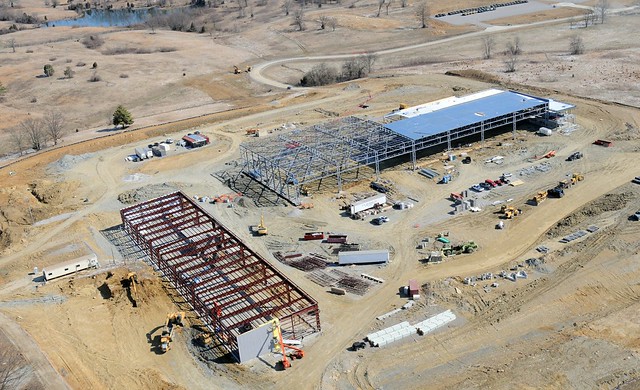Story by Maj. David Page, Kentucky National Guard Public Affairs
[caption id="" align="aligncenter" width="581"]

Aerial view of the new Army Aviation Support Facility on Boone National Guard Center in Frankfort, Ky. The new facility will more than quadruple its predecessor in space and will allow all aircraft to be stored indoors. (U.S. Army National Guard photo by Staff Sgt. Scott Raymond)
FRANKFORT, Ky. -- In mid January, Kentucky Army Aviators will open a new 126,000 square foot, $25 million Army Aviation Support Facility on the Boone National Guard Center in Frankfort.
The facility will have 18 aircraft bays that will feature the latest in aviation support to include in-ground vaults in the hangars to house data hubs as well as lubricants, air and water ports to assist in maintenance of the rotary-wing aircraft.
“The new facility will be four times the size of the current AASF,” said Chief Warrant Officer Ryan S. Thompson, Aircraft Maintenance Supervisor, Joint Forces Headquarters. “Plus, it will have bays to house our aircraft, which will keep them out of the elements, therefore helping us reduce corrosion by as much as 80 percent and reduce the risk of lightning strikes on the flight line.”
[caption id="" align="alignleft" width="273"]

Workers making progress on the new Army Aviation Support Facility during a July visit from Kentucky's adjutant general, July 16, 2014. (U.S. Army National Guard photo by Maj. David Page)
Click here to see more photos from this story.
Besides the increased size, the new AASF is registered as a LEED (Leadership in Energy & Environmental Design) Silver certified facility by the US Green Building Council. Silver is the second of four levels in LEED, and it is based on points for positive environmental aspects of a project. This certification recognizes the Kentucky National Guard for its environmental stewardship in the selection of building materials, methods, and energy savings initiatives.
“Our approach to savings on this facility is multi-faceted,” said Col Steven T. King, Construction and Facilities Management Officer. “Firstly, we are constructing a building that is tightly sealed, well insulated, and durable to minimize energy demand.
“Secondly, through sustainable design building principles, we are using the site orientation to take advantage of natural day-lighting, high-efficiency artificial lighting, active and passive solar strategies, geothermal heating and cooling, occupancy sensors and programmed thermostats to schedule HVAC shut down during periods of non-occupancy, such as nighttime and non-IDT (inactive duty training) weekends. This effort enables us to focus on minimizing our energy operating costs. ”
Another contributing factor to helping with the LEED certification is the solar panels that will be installed on the facility. These panels will help provide up to 80 kilowatts of energy, which will provide approximately 20% of the energy requirements for the building.
“Although we have 80kW of photovoltaic energy that we will produce, our goal is to add additional panels in the future to make this facility a truly Net-Zero energy building,” said King. “This means that we will generate an amount equal to or greater than the amount of energy we consume.”
[caption id="" align="alignright" width="318"]

The new Army Aviation Support Facility will have 18 aircraft bays featuring the latest in aviation support to include in-ground vaults in the hangars to house data hubs as well as lubricants, air and water ports to assist in maintenance of the rotary-wing aircraft. (U.S. Army National Guard photo by Maj. David Page)
Beyond the positive environmental impact, the facility was designed with the “user” in mind.
To that end, Col. King and his staff reached out to Col. Abney and his aviation team to talk about what they needed in a facility. The group then toured three other Aviation Facilities around the U.S. to gather lessons learned from those projects.
“During the tours, we looked at how each facility flowed and how we could make ours more efficient,” said Thompson. “We then worked with Chief Warrant Officer Four Larry Goode (a member of Col. King’s team) on the elements we wanted and he helped us get everything under one footprint.”
What resulted from the tours and the collaboration was a design that was not only functional for all units to be housed there, but some small touches to help the Soldiers be more efficient. For example, the component support shops that provide maintenance functions are located immediately adjacent to the hangar floor, which enhances the overall logistical flow of the entire operation.
Another critical feature of the new building will be the fire suppression system in the hangars. In case of a fire, the system will fill the hangar up to 8’ of foam within 10 minutes to dowse a fire.
“We are looking forward to moving into the new facility,” said Thompson. “This has been a long-time in the making so it will be a great day when we cut the ribbon.”
As for the existing AASF, it will be receiving a new tenant as well. The Combined Support Maintenance Shop, also located on Boone Center, will move to help provide more space on the post.